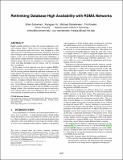| dc.contributor.author | Zamanian, Erfan | |
| dc.contributor.author | Yu, Xiangyao | |
| dc.contributor.author | Stonebraker, Michael | |
| dc.contributor.author | Kraska, Tim | |
| dc.date.accessioned | 2022-07-20T21:40:41Z | |
| dc.date.available | 2021-09-20T18:21:39Z | |
| dc.date.available | 2022-07-20T21:40:41Z | |
| dc.date.issued | 2019 | |
| dc.identifier.uri | https://hdl.handle.net/1721.1/132283.2 | |
| dc.description.abstract | © 2019, is held by the owner/author(s). Highly available database systems rely on data replication to tolerate machine failures. Both classes of existing replication algorithms, active-passive and active-active, were designed in a time when network was the dominant performance bottleneck. In essence, these techniques aim to minimize network communication between replicas at the cost of incurring more processing redundancy; a trade-off that suitably fitted the conventional wisdom of distributed database design. However, the emergence of next-generation networks with high throughput and low latency calls for revisiting these assumptions. In this paper, we first make the case that in modern RDMAenabled networks, the bottleneck has shifted to CPUs, and therefore the existing network-optimized replication techniques are no longer optimal. We present Active-Memory Replication, a new high availability scheme that efficiently leverages RDMA to completely eliminate the processing redundancy in replication. Using Active-Memory, all replicas dedicate their processing power to executing new transactions, as opposed to performing redundant computation. Active-Memory maintains high availability and correctness in the presence of failures through an efficient RDMA-based undologging scheme. Our evaluation against active-passive and activeactive schemes shows that Active-Memory is up to a factor of 2 faster than the second-best protocol on RDMA-based networks. | en_US |
| dc.language.iso | en | |
| dc.publisher | VLDB Endowment | en_US |
| dc.relation.isversionof | 10.14778/3342263.3342639 | en_US |
| dc.rights | Creative Commons Attribution-NonCommercial-NoDerivs License | en_US |
| dc.rights.uri | http://creativecommons.org/licenses/by-nc-nd/4.0/ | en_US |
| dc.source | VLDB Endowment | en_US |
| dc.title | Rethinking database high availability with RDMA networks | en_US |
| dc.type | Article | en_US |
| dc.contributor.department | Massachusetts Institute of Technology. Computer Science and Artificial Intelligence Laboratory | en_US |
| dc.contributor.department | Massachusetts Institute of Technology. Department of Electrical Engineering and Computer Science | en_US |
| dc.relation.journal | Proceedings of the VLDB Endowment | en_US |
| dc.eprint.version | Final published version | en_US |
| dc.type.uri | http://purl.org/eprint/type/ConferencePaper | en_US |
| eprint.status | http://purl.org/eprint/status/NonPeerReviewed | en_US |
| dc.date.updated | 2021-01-11T16:24:51Z | |
| dspace.orderedauthors | Zamanian, E; Yu, X; Stonebraker, M; Kraska, T | en_US |
| dspace.date.submission | 2021-01-11T16:24:53Z | |
| mit.journal.volume | 12 | en_US |
| mit.journal.issue | 11 | en_US |
| mit.license | PUBLISHER_CC | |
| mit.metadata.status | Publication Information Needed | en_US |
